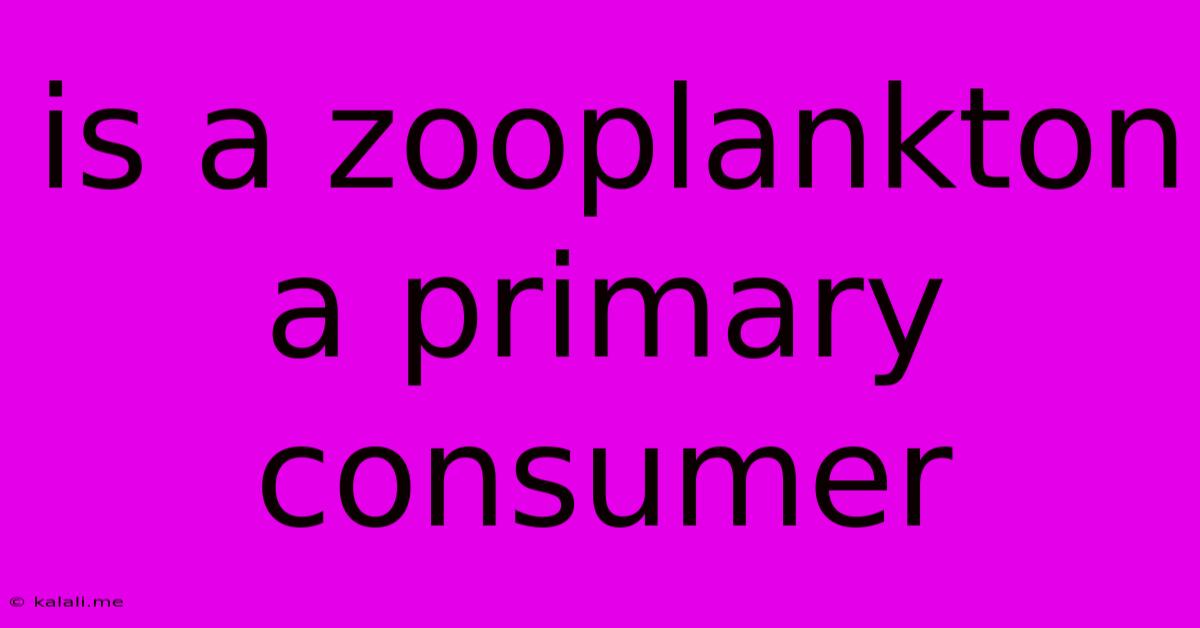Is A Zooplankton A Primary Consumer
Kalali
Jun 15, 2025 · 3 min read

Table of Contents
Is Zooplankton a Primary Consumer? A Deep Dive into the Food Web
Meta Description: Zooplankton's role in the aquatic food web is crucial. This article explores whether zooplankton are primary consumers, examining their diet and position within the ecosystem. Discover the intricacies of aquatic food chains and the importance of zooplankton.
Zooplankton, the tiny animals drifting in our oceans, lakes, and rivers, play a vital role in aquatic ecosystems. But where exactly do they fit within the complex food web? A common question is: are zooplankton primary consumers? The short answer is: mostly yes, but with important nuances.
Understanding Trophic Levels and Primary Consumers
Before we dive into the specifics of zooplankton, let's define some key terms. A trophic level refers to the position an organism occupies in a food chain. Primary consumers are herbivores – organisms that feed directly on primary producers, which are typically photosynthetic organisms like phytoplankton (microscopic algae) and other aquatic plants. These primary producers form the base of the aquatic food web, converting sunlight into energy through photosynthesis.
Zooplankton's Diet: Primarily Herbivorous, But Not Always
The majority of zooplankton species are indeed primary consumers. They graze on phytoplankton, consuming vast quantities and acting as a crucial link between the primary producers and higher trophic levels. This herbivorous feeding strategy is crucial for energy transfer within the aquatic ecosystem. Think of it like this: phytoplankton capture the sun's energy, and zooplankton efficiently transfer that energy up the food chain.
Examples of zooplankton that primarily consume phytoplankton include:
- Copepods: These tiny crustaceans are arguably the most abundant zooplankton and are significant phytoplankton grazers.
- Daphnia (Water Fleas): These crustaceans are also known for their herbivorous diets, filtering phytoplankton from the water.
- Rotifers: These microscopic animals are another important group of zooplankton that feed primarily on phytoplankton.
The Exceptions: Omnivorous and Carnivorous Zooplankton
However, it's inaccurate to classify all zooplankton as strictly primary consumers. Some zooplankton exhibit omnivorous feeding habits, meaning they consume both plants and animals. They might supplement their phytoplankton diet with smaller zooplankton, bacteria, or detritus (organic debris).
Furthermore, some zooplankton species are carnivorous, feeding on other zooplankton, thus occupying a higher trophic level as secondary consumers. These carnivorous zooplankton play an important role in regulating zooplankton populations and shaping community structure. Examples include certain predatory copepods and larger jellyfish.
Zooplankton's Importance in the Food Web
Regardless of their specific dietary preferences, zooplankton are undeniably keystone species in aquatic ecosystems. Their role as primary (and sometimes secondary) consumers is critical for:
- Energy Transfer: They efficiently transfer energy from primary producers to higher trophic levels, supporting entire food webs.
- Nutrient Cycling: Their grazing activity and waste products contribute significantly to nutrient cycling within the aquatic environment.
- Food Source: They serve as a critical food source for many fish, invertebrates, and even marine mammals and birds.
Conclusion: A Complex but Crucial Role
In summary, while many zooplankton species are indeed primary consumers, feeding primarily on phytoplankton, the reality is more nuanced. Some zooplankton exhibit omnivorous or carnivorous feeding strategies, occupying different trophic levels. However, their overall importance as a crucial link in the aquatic food web remains undeniable, highlighting their vital role in the health and functioning of aquatic ecosystems worldwide. Understanding their diverse feeding habits is key to comprehending the complex dynamics of these essential ecosystems.
Latest Posts
Latest Posts
-
The O2 Released During Photosynthesis Comes From
Jun 15, 2025
-
Where Are The Horse Latitudes Located
Jun 15, 2025
-
What Is The Lcm Of 30 And 20
Jun 15, 2025
-
Does Cal Poly Pomona Require Sat
Jun 15, 2025
-
The Atmosphere Of Mars Is Composed Mostly Of
Jun 15, 2025
Related Post
Thank you for visiting our website which covers about Is A Zooplankton A Primary Consumer . We hope the information provided has been useful to you. Feel free to contact us if you have any questions or need further assistance. See you next time and don't miss to bookmark.